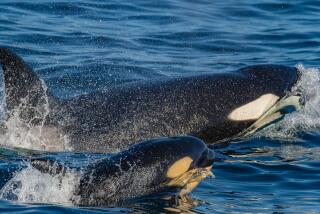Tradition Gives Way to Technology Among Village’s Whalers
- Share via
LORINO, Russia — Armed with military rifles and pursuing their prey in motorboats, the Chukchi men of this coastal village have become the most proficient whale hunters in Russia.
With the breakup of the Soviet Union--and the end of its control over whaling by indigenous people--Lorino’s inhabitants began hunting in the Bering Strait in 1994 for California gray whales to feed themselves and their foxes.
The tradition of hunting whales in sealskin boats with 10 paddlers and a fearless harpooner has long faded into Russian history. But unlike other villages on the Chukotka Peninsula, Lorino has been able to adapt the traditional hunt to modern methods.
In summer, lookouts on the bluff continually scan the sea in search of the telltale spout of a gray whale. When the weather is calm--or when a spout is sighted from shore--20 hunters head out in eight motorboats that can easily overtake a whale.
Usually, the hunters come back with at least one whale--and sometimes as many as six.
“We go toward the strait, and we are almost always able to find one,” said Grigory Owtoy, 37, leader of a 10-man hunting squad. “Sometimes it takes an hour. Sometimes it takes a day.”
When the lead boat gets within 10 yards of a whale, one of the hunters throws a specially designed harpoon that leaves a foot-long barbed iron shaft sticking out of the animal. The whale immediately dives, but the shaft is fastened to a buoy whose movement shows the hunters which way the animal is heading.
At first, the hunters tried shooting the whales with old military antitank guns. But those weapons proved too dangerous to the hunters. Now, when a whale surfaces for air, the hunters open fire with .30-caliber carbines, shooting the animal 350 to 500 times before it dies.
“After the first harpoon and buoy, we start shooting to stop him from escaping,” said the short, muscular Owtoy. “Usually we use a whole crate of ammunition, and that’s 400” rounds.
To keep the whale afloat, the hunters attach more buoys--up to 14, depending on the size of the whale. Then, they radio for a larger boat to come and haul the carcass to shore. When necessary, the boat can tow up to three whales at a time.
At the village, a tractor pulls the whale onto the beach, and all the people--Chukchis, Eskimos and Russians--are invited to bring their knives and cut off as much meat as they want. Lorino was historically a Chukchi village, but today Chukchis make up 83% of its population, with 4.6% Eskimos and the rest Russians and other Europeans.
Standing or kneeling on both sides of the animal, the villagers work together to peel off the whale’s hide and blubber and carve off the meat in strips up to 2 feet long. Some pause long enough to eat a piece of meat raw. Sometimes a dog from the village joins in and takes a bite of the carcass.
When the villagers are done butchering the whale, whatever meat they don’t take--which is usually most of the whale--goes to feed the 5,000 foxes at Lorino’s fur farm.
More to Read
Sign up for Essential California
The most important California stories and recommendations in your inbox every morning.
You may occasionally receive promotional content from the Los Angeles Times.













